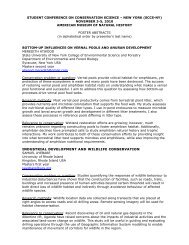"Life and the Evolution of Earth's Atmosphere." Earth
"Life and the Evolution of Earth's Atmosphere." Earth
"Life and the Evolution of Earth's Atmosphere." Earth
- No tags were found...
You also want an ePaper? Increase the reach of your titles
YUMPU automatically turns print PDFs into web optimized ePapers that Google loves.
(paleosols) <strong>and</strong> a variety <strong>of</strong> o<strong>the</strong>r geologicalevidence indicates that starting about 2.5 billionyears ago, sedimentary rocks began to becomeincreasingly affected by higher amounts <strong>of</strong>oxygen in <strong>the</strong> atmosphere, <strong>and</strong> appear red, asthough “rusted.” Scientists believe that oxygenconcentration began to rapidly increase at thattime because more oxygen began to beproduced by photosyn<strong>the</strong>sis than could bewhisked away by reactions with <strong>the</strong>atmosphere, oceans, <strong>and</strong> rocks. A thresholdhad been reached, <strong>and</strong> <strong>the</strong> rise <strong>of</strong> oxygen hadbegun. At around that same time, morecomplex bacterial life evolved in response to <strong>the</strong>oxygen-rich conditions, including organisms witha true cell nucleus (Eukaryotes) from which allplants, animals, <strong>and</strong> fungi are descended.The final significant section in <strong>the</strong> emergence <strong>of</strong>an oxygen-rich atmosphere on <strong>Earth</strong> beganabout 700 million years ago, when <strong>the</strong> fossilrecord documents <strong>the</strong> emergence <strong>of</strong>multicellular organisms. When oxygen levelsbecame high enough, a little more than onepercent <strong>of</strong> <strong>the</strong> present level, a powerful ozonescreen started to form in <strong>the</strong> upper atmospherethat protected <strong>the</strong> first l<strong>and</strong>-dwelling creaturesfrom <strong>the</strong> Sun’s harmful ultraviolet radiation.Abundant oxygen in <strong>the</strong> atmosphere wasessential to <strong>the</strong> rise <strong>of</strong> animal <strong>and</strong> plant lifeon l<strong>and</strong>.A Hot FutureKnowing what we do about <strong>the</strong> past trends inatmospheric evolution <strong>of</strong> <strong>the</strong> <strong>Earth</strong>, what can wesay about <strong>the</strong> distant future for life on thisplanet? The Sun will continue to grow brighterover <strong>the</strong> 5 billion years or so that remain in itsstellar life span. Its luminosity has beenincreasing on a near-linear path for more than4.5 billion years because hydrogen iscontinually converted into <strong>the</strong> heavier element,helium, by nuclear fusion. This conversionreleases tremendous amounts <strong>of</strong> energy everysecond <strong>and</strong> is responsible for sunlight. Ashelium accumulates, <strong>the</strong> average density <strong>of</strong> <strong>the</strong>Sun increases over time, which in turn causespressures <strong>and</strong> temperatures in <strong>the</strong> Sun’s interiorto increase. These higher pressures <strong>and</strong>temperatures increase <strong>the</strong> rate <strong>of</strong> fusion, <strong>and</strong><strong>the</strong> extra energy that is generated leads toincreased luminosity. As this positive feedbackcontinues, <strong>the</strong> Sun will continue to increase inintensity by about six percent or more in <strong>the</strong>next billion years.One <strong>of</strong> two things needs to happen to keep <strong>the</strong><strong>Earth</strong> from slowly going <strong>the</strong> way <strong>of</strong> deadly hotVenus. Ei<strong>the</strong>r almost all <strong>of</strong> <strong>the</strong> greenhousegases have to be removed from <strong>the</strong>atmosphere, or <strong>the</strong> planet’s albedo—<strong>the</strong>amount <strong>of</strong> sunlight <strong>the</strong> surface can reflect backinto space—must increase. Unless new plantsevolve a type <strong>of</strong> photosyn<strong>the</strong>sis that requiresvery little carbon dioxide, or some future culturesomehow protects <strong>the</strong> <strong>Earth</strong> from a brighterSun, life on l<strong>and</strong> will have to be ab<strong>and</strong>oned. In<strong>the</strong> end, some 5 billion years from now, much<strong>of</strong> <strong>the</strong> Sun’s fuel will be exhausted. The Sun willbegin to grow as it approaches <strong>the</strong> Red Giantphase <strong>of</strong> its stellar life cycle. By <strong>the</strong>n, <strong>the</strong>oceans on <strong>Earth</strong> will have long since boiledaway. The last life, primitive bacteria much like<strong>the</strong> first that appeared, residing in deep crustalrocks <strong>and</strong> sediments, will have perished. As <strong>the</strong>surface temperature rises, all <strong>of</strong> <strong>the</strong> volatilegases stored over many eons in <strong>the</strong> <strong>Earth</strong>’scrust will be released to form a thick, hot,blanketing atmosphere. Finally, <strong>the</strong>re will betwin Venuses from that time until <strong>the</strong> end <strong>of</strong> <strong>the</strong>solar system.SummaryA great deal can be learned by approaching<strong>the</strong> history <strong>of</strong> life on <strong>Earth</strong> from <strong>the</strong> st<strong>and</strong>point<strong>of</strong> geology. The rocks that make up <strong>the</strong>geologic record preserve changes in <strong>the</strong>planet’s crust, oceans, <strong>and</strong> atmosphere thathave accompanied <strong>the</strong> history <strong>of</strong> <strong>the</strong>evolution <strong>of</strong> life. Studies <strong>of</strong> <strong>the</strong> geologic record
















